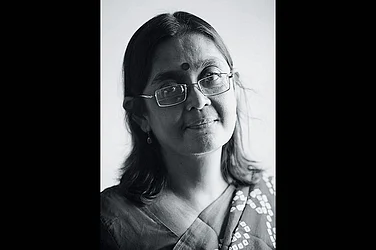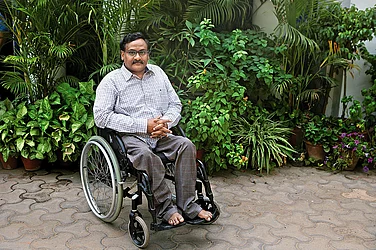As I have said elsewhere in this book, India is an affirmatively legislated country. However, that does not negate the fact that India is also a deeply superstitious country. Perforate this veil of ignorance and superstition, and we will find that what lies beneath is a patriarchal thirst for female subjugation. British author, Francine Toon famously wrote: ‘We are the grand-daughters of the witches you couldn’t burn’— this is now a commonly seen slogan at feminist protests. The witch has come to symbolise misogyny’s long, grim history and the need for remembrance. Toon goes on to say that a witch represents a deeply feminine power bereft of patriarchy. While that may be the case in the Western world, women in India are fighting a battle of their own. According to data from the National Crime Records Bureau (NCRB), more than 2,500 people, mostly women, have been killed in India between 2000-2016 on grounds of being accused of witchcraft, putting the number to more than 150 deaths annually. That is 150 women every year being subjected to this kind of insanity and irrationality.
According to available data, witch-hunting is prevalent in the states of Jharkhand, Bihar, West Bengal, Odisha, Haryana, Gujarat, Rajasthan, Madhya Pradesh, Uttar Pradesh, Assam, Chhattisgarh and Maharashtra. An article in Down to Earth explains that an approximate 24% cases of witch hunting were triggered by land grabbing. At this juncture, we may compare two equally vicious and patriarchal practices, namely, sati and witch hunting. While India may have abolished sati, an archaic practice wherein a widow was forced to self-immolate herself by jumping into her husband’s funeral pyre, the brutal and unfounded practice of witch-hunting is sadly still prevalent.
To begin with, women in Odisha are blamed for crop failure or causing health issues. As late as 2013, the state of Odisha promulgated a legislation banning witch-hunting. A landmark report by the Odisha State Commission for Women and Action Aid, an international non-governmental organisation, collected case studies of 102 victims of witch-hunting and witch-branding in the state. The report observed that the practice of witch hunting is: ‘common in communities with unequal socio economic systems and gender inequality, inadequate healthcare and widespread illiteracy. Women, especially Dalits and tribal people, bore the brunt of exploitation and brutality.’ The Action Aid report gives a gender dimension to these witch hunts claiming that those women who dared to assert themselves have been victims of such atrocities. The study finds the primary cause of being branded a witch to be closely associated with: ‘the health of children and other villagers, land grabbing, mental health issues and crop failure. More than 30% cases led to death of the victim and 70% resulted in the victim or distribution and their family leaving the area. Single women who were widowed or separated were found to be the most vulnerable groups to witch-branding related crimes. The children of the victims continued to face the brunt of the stigma and were denied their fundamental rights. Only 69% of the cases saw police intervention, investigation and arrest.’
The state of Bihar was one of the first to introduce a legislation on witch-hunting, thereby making it a penal offence. Its objective was to: ‘provide for the effective measures to prevent the witch practices and identification of a woman as a witch and their oppression mostly prevalent in Tribal areas and elsewhere in the State of Bihar and to eliminate the woman’s torture, humiliation and killing by the society and for any other matter connected therewith or which are incidental thereto.’
The legislation criminalises those indirectly identifying a woman as a witch as well as those directly causing physical or mental torture. The Act defines a witch as someone being identified by persons in the community as having the power of harming another person ‘through the art of black magic, evil eyes, or ‘mantras’. However, it is worth pointing out that the charging section under the Act only imposes a fine of ₹1,000 or an imprisonment of three months. Most state legislation on witch-hunting is gender specific. That is, there is an in-built presumption in the statute that assumes the victim to be a female while those being charged of an offence under the statute has been deliberately kept gender neutral by including both men and women as culprits of the crime. Yet an analysis of the law shows that the punishment awarded is not enough to reprimand the evil that the crime perpetuates.
In other words, the laws in place are insufficient to deal with the enormity of the practice that is witch hunting. Moreover, looking at the incongruity between the vastness of the practice and what the statistics convey, we can reasonably deduce that reporting of the cases remains abysmal. Perhaps the needs of the victims and survivors of witch-hunting have not been adequately looked into. Compensation and rehabilitation of victims is an aspect that needs serious consideration by the state governments. Reparations need to be made for forced displacement from the village, physical assault by mobs as well as loss of income due to social ostracism. At this juncture, a few questions arise: Does India need a central legislation banning witch-hunting and terming it a crime? Despite what the data indicates, are we immune to the atrocities faced by women (mostly rural) from these twelve states? Why do we find the practice of witch-hunting in the deeply patriarchal societies of Bihar and Rajasthan as opposed to states with matriarchal structures? Why is it that we don’t witness the heinous enactment of witch-hunting in matriarchal states like Kerala? Another trend that emerges from this data is that there are no reports of witch-hunting in states with higher literacy rates and good socio-economic conditions. In 2016, The Prevention of Witch-hunting Bill was introduced in the Lok Sabha by, the then Bhartiya Janta Party Member of Parliament, Raghav Lakhanpal.
A detailed Bill, it makes specific provisions for relief and rehabilitation of women who are victims of witch hunting. Furthermore, it makes the government accountable for having in place rehabilitation mechanisms and schemes for victims of witch-hunting as well as directing the government to launch public awareness schemes to inform communities of the provisions of the law. The Bill also provides for free medical assistance to the victims and free legal aid to the aggrieved women. Perhaps it is time to revisit the conversation surrounding the prevalence of this practice and review the Prevention of Witch-hunting Bill.
In the absence of a central legislation on the subject, the statement of objectives and reasons of the Bill states that various sections of the IPC are used to book offenders that are deficient in dealing with the atrocity of the crime.
Analysing the existing data and literature on witch hunting in India, it is also worth pointing out that the media, as a tool of culture, plays an important role in shaping societal mentality. With films like Bhool Bhulaiya 2 that toy with the notion of women as witches, the superstition is pushed deeper in the psyche of the general viewing public. In order to remedy this situation, we must promote education and awareness about the evils of witch-hunting in schools so that the notion itself is eradicated at its roots. An article in Vice India depicts how a woman was branded a witch and later made to sign a paper that said she agreed to divorce her husband with a meagre compensation of ₹20,000 ($270). Fearing for her life and safety, she was forced to comply. Another article in Rural India shows how 10-15 complaints of women being branded as witches and facing harassment by fellow villagers are received every month at the local police station in Bhilwara district of Rajasthan. The article goes on to say how influential people in a village often invoke the madness created by witchcraft to victimise and harass a woman, especially a widow or single woman who might be illiterate or ‘incapable of fighting a legal battle financially, and this is usually a ploy to grab her land’. This reeks of a feudal and malicious system armed with the power of superstition bearing the sole objective of exploiting women from poor or low castes.
If we were to observe closely, we will find that witch hunting and being branded as a witch entails a violation of human rights, at a very rudimentary level. For it is the persecution of women after being labelled as a witch and the harrowing atrocities they are forced to undergo that erodes the basic constitutional rights granted to them by virtue of being citizens of the country.
Toon argues the witch to be a ‘conduit for pain, defiance and female power’, calling her a healing figure that is gender-inclusive. So far we have witnessed a history of misogyny. A history of oppression. Witch hunting, be it in 16th-century America or modern-day India, is a tactic of suppressing women, for demeaning women, searing and branding them as unequal citizens of the country. Shrouded in stigma and superstition, witch branding and hunting is nothing more than plain assault and murder. All these are only techniques of imputing blame on women for any unfortunate incident that befalls members of a community. While women in the West are reclaiming the word ‘witch’ as a powerful tool of instilling trepidation in the minds of men, the plight of rural women in India mirrors that of young girls accused of witch-craft in Salem, Massachusetts in the 1690s. It is important to mention here that around 200 people, mostly young girls and women, were accused, arrested, prosecuted and later hanged for witchcraft in colonial Massachusetts between 1692 to 1693. It is typically remembered as one of the more shameful episodes of mass hysteria and misogyny in the United Stated of America, where 78% of the people accused of witchcraft were women. The women who were falsely implicated, according to research, had been forward thinking and often subversive women who were claimed by the community to have been possessed by the devil.
A witch is considered a threatening figure but today, in modern and independent India, women are being termed witches not because people in general are afraid of them but because women make for easy targets. It is this systemic and deliberate oppression of women that deserves our attention. And it deserves our attention because Article 14 of the Constitution of India guarantees equality before the law and equal protection by the law regardless of whether a citizen is a man or woman, residing in rural or urban areas. Witch-hunting is also violative of Article 15 and Article 16 wherein the former prohibits discrimination on the basis of gender (among other things such as caste, religion etc) as it is evident that the said practice is another dimension of gender based discrimination while the latter promises the right to life with dignity. Although Article 16 prohibits torture, the law is being flouted and women are mercilessly being harassed and persecuted. The fact that this abominable practice has been going on unnoticed, without interference by concerned police authorities, flying under the radar of state human rights commissions, is enough cause for concern and alarm.
We must also see how violence perpetrated against women in our country is rooted in the violence of framing and othering women in so many different ways, which then serves as a justification of that violence. So the answer to our concern lies in what can be done to improve the situation. To begin with, the government along with NGOs at the grassroots level must prepare themselves for a targeted and continual effort to eradicate this practice by having in place campaigns that cater to reason and science as opposed to superstition and the supernatural.126 These campaigns must have specific emphasis on the states wherein witch-hunting is most widespread. Additionally, looking at the fact that various provisions of the IPC are being used to prosecute people for witch-hunting, perhaps better coordination is required between the police enforcement and the prosecution department. Additionally, the national and state human rights commissions must monitor cases of witch-hunting and ensure such complaints are not returned by the police authorities. Frontline workers, anganwadi workers and NGOs focusing on women and childcare must work in tandem with the state and district level authorities to make an environment conducive for women to report such atrocities. May sanity and the law prevail.
(This is excerpt from the book ‘In The Body Of A Woman: Essays on Law, Gender and Society’ by Aaliya Waziri. It is published with the publisher’s permission.)





















